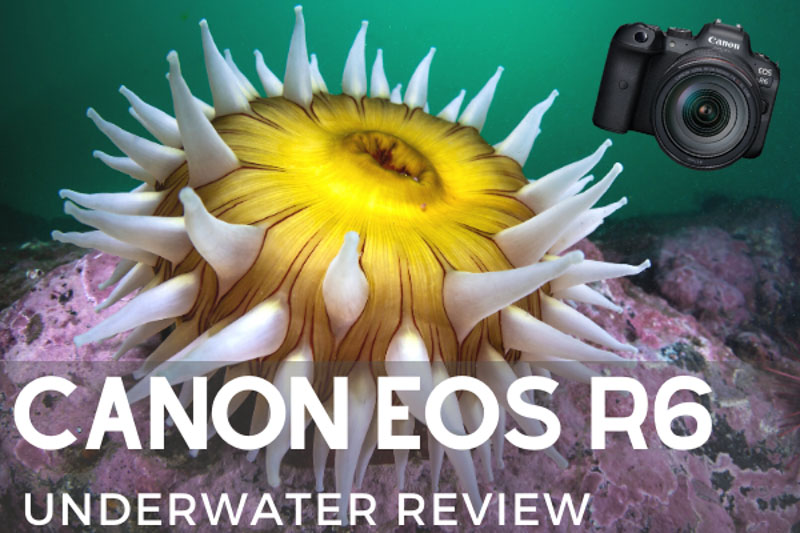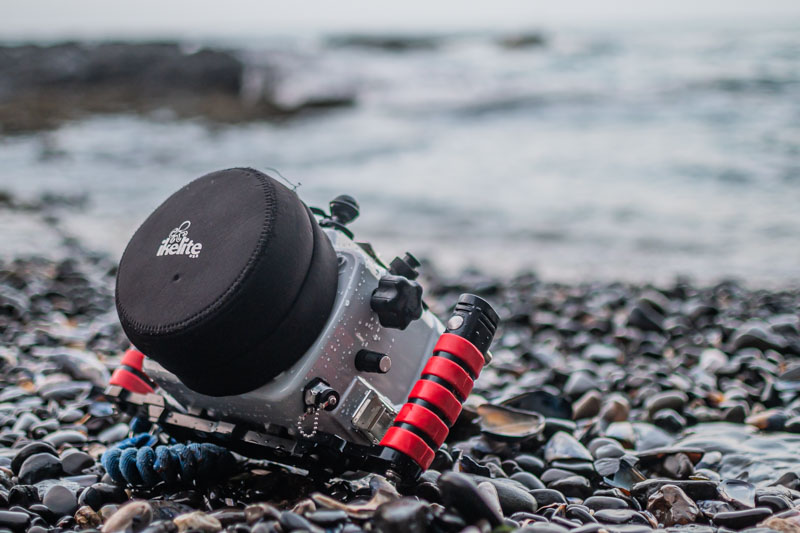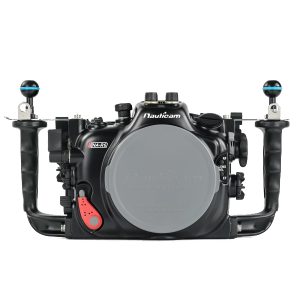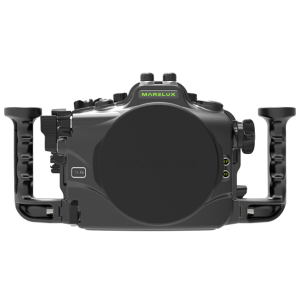Canon EOS R6 Underwater Review
January 25th, 2021
Canon EOS R6 Underwater Review: The Top "Prosumer" Camera of 2021
The Canon EOS R6 is Canon's newest prosumer level EOS R camera model, released alongside the groundbreaking EOS R5. For those who are looking at purchasing their first full-frame system, and others who are looking for a great value-for-money camera body, the Canon R6 can be a more affordable choice than the R5. In fact, after extensive underwater testing, we consider the R6 to be a better option for underwater photo and video than the Nikon Z6 II and the Sony A7C. The R6 is equipped with many of the same cutting-edge features of the R5 including the best 5 axis in-body image-stabilization available, a quick dual pixel autofocus system with accurate animal eye AF tracking, and an excellent line-up of both EF and RF lenses that have proven over time to be some of the best underwater lenses for sale. In exchange for a reasonably priced body, retailing at $2,499, the R6 compromises in both video and photo resolution. The R6 is equipped with a 20.1 MP CMOS sensor that can record 4K video up to 60 fps.
We took the Canon EOS R6 diving in the cold, rugged waters of the Pacific coast of North America to test the efficacy of the camera's features for underwater photo and video. Though the camera's resolution is on the lower-end for a full-frame camera, we came back from our dives particularly happy with the image quality produced in low light conditions. For underwater video, we think the R6 is an amazing value for any full-frame mirrorless camera, with incredible stabilization, and beautiful 4K quality up to 60 frames per second. The specs sheet doesn't lie, the R6 is our favorite "prosumer" grade camera in 2021.
Canon EOS R5 vs R6
Why choose the R6 over the 8K behemoth of the R5? Well, price. The R6 body retails for $1400 less than the R5. For many, this can be the difference between purchasing an extra lens or a pair of strobes. And despite the lower retail price, the R6 still has many of the bells and whistles of the R5 including In-Body Image-Stabilization (IBIS), 12 fps/20fps electronic burst shooting speeds, autofocus points covering 100% of the sensor, animal eye autofocus tracking, and more! In terms of video capability, it is capable of 4K @ 60fps using the full width of the sensor, which is more than enough for most underwater videographers. And the R6 ranks even better than the R5 for low light capability - making it a compelling camera for cold water underwater photographers. Overall, the R6 is the more rational choice for photographers looking for pro and enthusiast-level performance at a great price point.
However, if you want the best-of-the-best that Canon can offer, the R5 is our top recommendation for a professional-grade underwater photo and video hybrid system in 2020. For the additional $1400, the R5 takes RAW video up to a resolution of 8K at 30fps. In 4K, it can capture slow-motion footage up to 120 fps. This means that you can crop your video and slow it down for stabilization more in the R5. When it comes to photography, the R5 can capture high resolution photographs at 45 megapixels of resolution. That's significantly more resolution than the R6's 20 megapixels. So if you shoot a lot of underwater macro photos, we recommend the R5. Higher resolution images allow you to crop a lot more and still retain quality. We also recommend the R5 for creating higher resolution and larger photo prints.
Check out our Canon EOS R5 vs Canon EOS R6 article for a full breakdown between the two cameras.
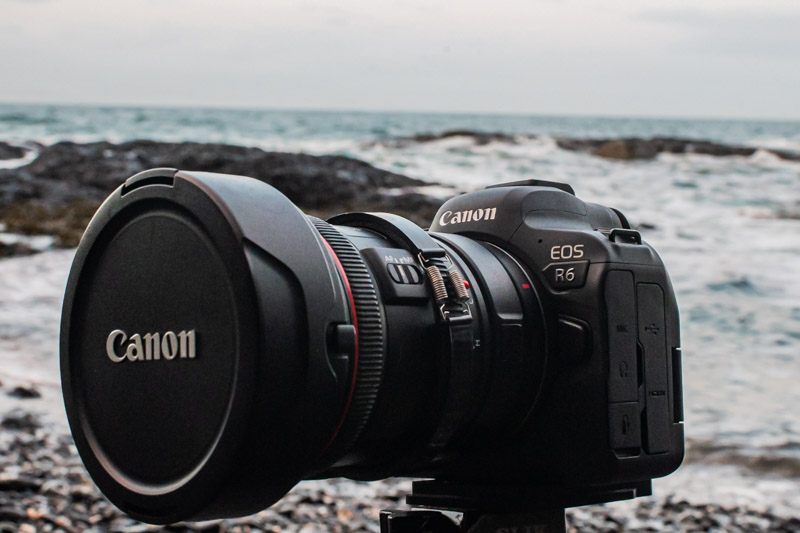
Canon EOS R6
Camera Body Status: Shipping Now
Underwater Housing Status: Shipping Now!
Contact us at sales@bluewaterphotostore.com to order a housing and for updates on housing releases.
U.S. MSRP Canon EOS R6: $2,499
Jump to Section
EOS R vs EOS R6 | Specifications | Key Features
EOS R6 for Underwater Photo and Video | Who Should Buy? | Underwater Lenses
Underwater Housings | Conclusions
Purchase a Canon EOS R6 underwater housing at Bluewater Photo:
Nauticam Canon EOS R6 Underwater Housing
Ikelite Canon EOS R6 Underwater Housing
Sea & Sea Canon EOS R6 Underwater Housing
Aquatica Canon EOS R6 Underwater Housing
Isotta Canon EOS R6 Underwater Housing
Marelux Canon EOS R6 Underwater Housing
Need help choosing a housing? Check out our Canon EOS R6 Underwater Housing Buyer's Guide
Canon EOS R6 Compared with Canon EOS R
The Canon EOS R was Canon's first attempt at a full-frame mirrorless camera. With many good options from Sony and Nikon, it fell short. Fortunately, the Canon EOS R6 addresses many of these concerns.
For underwater photography, Canon was lagging behind Sony and Nikon because of a lack of in-body image-stabilization. The Canon EOS R5 and R6 are Canon's first cameras with IBIS, capable of 7-8 stops of correction when combined with a stabilized lens. The EOS R6 also has the capability of shooting 12 frames per second with the mechanical shutter (20 fps electronic), vs the 8fps on the EOS R! Did we mention dual card slots?
The EOS R6 has a new 20.1 MP CMOS sensor, which has been speculated to be the same sensor as the Canon 1DX Mark III. If that's true, one could say the R6 features the same sensor as what is found in a camera body priced over $6K! Strangely enough, this is actually less resolution than what was originally available on the 30.3 MP EOS R. It's a strange decision for Canon which prices the cameras at similar price points. In every other way, the EOS R6 is a more advanced camera, but we were disappointed to see such a low resolution. However, the lower resolution does help the R6 achieve amazing low light feats including lower noise in high ISO photos as well as high burst rates. Overall, after our underwater tests, we weren't bothered all that much by the resolution. Some macro images could have benefited from higher quality crops, but our wide angle photographs looked wonderful with excellent dynamic range.
For underwater videography, Canon fell short of its competitors by offering cropped 4K video in the original EOS R. The EOS R6 goes above-and-beyond at addressing these concerns with 4K video up to 60 fps using an acceptable 16:9 crop (1.07X). It should still be more than enough for most professional underwater videographers - especially compared to competitors like the Nikon Z6 II.
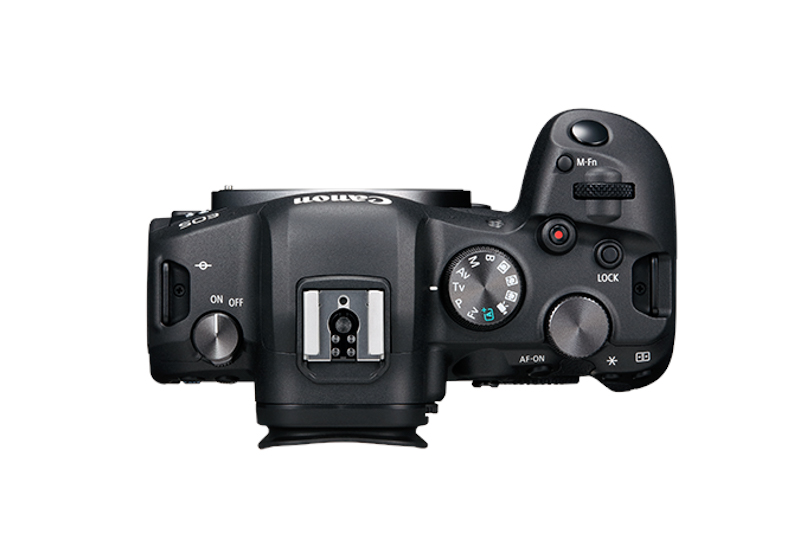
Canon EOS R6 Specifications
Key Canon EOS R6 Specs
- 20.1 Megapixel Full-Frame CMOS Sensor and Digic X processor
- Canon's first 5 axis In-Body Image-Stabilization (IBIS) system which works in conjunction with optical IS RF and EF lenses. Up to 8 stops of correction
- Improved Dual Pixel II Autofocus
- ISO 100-102400
- 100% of the sensor has AF coverage!
- Animal eye AF detection (for birds, cats, and dogs) - we'll see if it works for fish!
- 12fps burst shooting with a mechanical shutter
- 20 fps burst shooting with a silent (electronic shutter)
- Dual card slots - 2x SD UHS-II
- Internal C-Log recording
- 4K video up to 60 fps, 10-bit 4:2:2 (16:9, 1.07X crop)
- HD recording up to 120fps
- 3.69 million dot EVF
- Dimensions: 138.4 mm X 97.5mm X 88.4 mm
- Weight: 680grams (including battery)
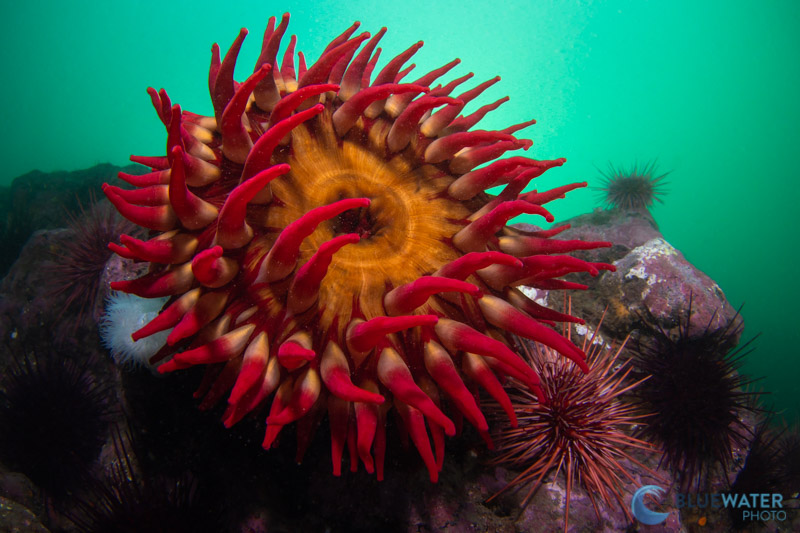
A wide angle scene photographed with the Canon EOS R6 and Canon 8-15mm fisheye lens in an Ikelite EOS R6 housing. Effective IBIS and a slow shutter speed allow for excellent image quality with a colorful background. f/13, 1/50, ISO 250
Canon EOS R6 Key Features
Body and Build
The Canon EOS R6 is built similarly to the EOS R and EOS R5. Like the R5, the R6 does have a little bit of a plastic-but-solid feel. Even though it's a mirrorless camera, it's only a tad bit smaller than its DSLR counterparts. In most cases, due to the size of RF and EF glass, we think underwater housing manufacturers will need to use their DSLR port systems. Therefore, we anticipate the full EOS R6 underwater system to be about the same size as a DSLR system, despite the added size benefits of mirrorless cameras. The EOS R6 does require a separate housing from the R5 and EOS R, despite there only being a 3 mm difference between the width of the R6 and R5. The R6 is slightly lighter than the R5, but we did not find a noticeable difference during our dives.
The button placement on the camera is very natural. Canon users should be able to easily adapt to the system and the ergonomics of the EOS R6 are splendid. It just might be the best in its class of mirrorless cameras across all brands. Canon discontinued the use of the touch bar that many found annoying on the original EOS R. They replaced it with a classic joystick control and added a wheel to where the D-pad used to be. We think these button improvements will make it an even more compelling camera from the standpoint of useability - clearly surpassing the Sony A7R IV and even the Nikon Z7. Underwater, it is important to note that some housing manufacturers may not have compatibility for the joystick which is used to select AF points. If this is the case, the easiest thing to do is to assign a button to select the AF point and control the AF point selection with the three dials on the camera. After our muscle memory established itself, we found that selecting AF points with the dials was actually faster than the joystick. In fact, many of the menus are easier to scroll through using the dials. For more information on recommended custom settings and other settings, check out our underwater settings guide for the Canon EOS R5 and EOS R6.
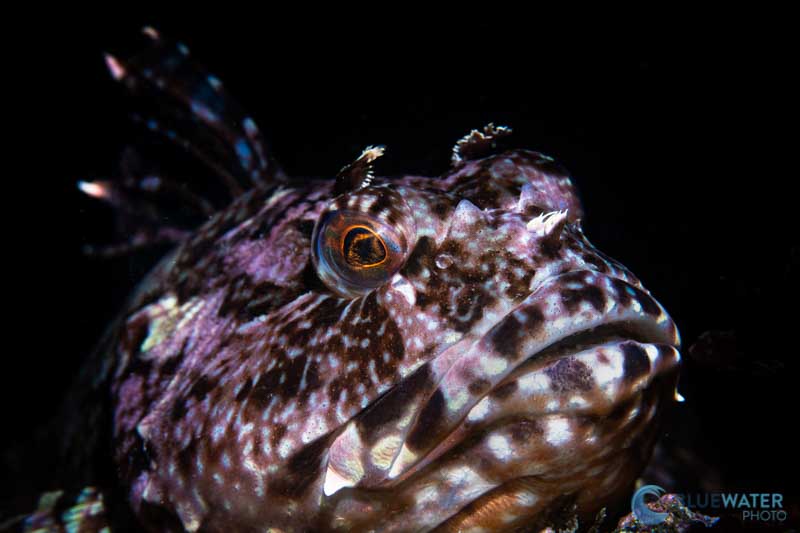
Effective ergonomics and easy underwater controls allow for quick settings changes with the R6 to capture skittish subjects like this cabezon. Photographed with the Canon EOS R6 and Canon 100mm macro lens in an Ikelite EOS R6 housing. f/16, 1/160, ISO 200
Battery Life
The Canon R6 has a battery life rated at 510 shots with the LCD and 380 shots with the EVF. This puts it solidly in the middle for a camera of its class. We did all of our dives with the LCD and found that we were able to easily do three dives with one battery and could likely push the camera to four dives. If you shoot more video than photos, the battery will likely drain quicker.
Overheating Concerns
Almost immediately following the release of the R5 and R6, concerns about overheating when shooting high resolution video surfaced. For the sake of size, the EOS R6 body does not have a built in cooling system. Therefore, when shooting 4K @ 60p there is a 30 minute time limit on individual clips. This is similar to the 30 minute recording limit on the Nikon Z6 II/Z7 II. This isn't quite as limiting as the R5 in 8K, but it is a cause for concern for some underwater videographers. At 4K @ 30p the camera can record for 40 minutes. Coldwater divers might be able to get longer run times out of the camera before needing to take a break from recording, but warm water divers could suffer shorter times. Either way, we recommend adding desiccant packets to your system to minimize fogging.
In our experience, we found that when we shot a mix of photos and videos over the course of the dive, we had no problems with overheating. It would require constant recording for most of a dive before the R6 overheats, and it certainly fairs better than the R5 in this regard. However, if the camera does overheat, there is a recovery time of roughly 10 minutes before it can record 10 more minutes of footage. In many cases the dive would likely be over at this point. Overall, for a camera of its class the R6 isn't too different from other cameras regarding recording times for 4K @ 60p. Check out our overheating tests for more information about overheating in the Canon EOS R5.
Image Quality, Processing, and Burst Speeds
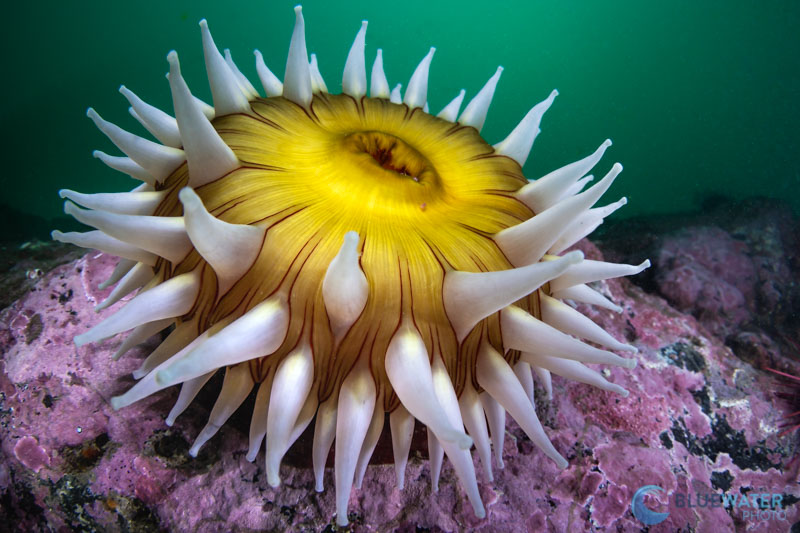
This image shows the beautiful image quality and dynamic range that the R6 is capable of capturing. This anemone was photographed with the Canon EOS R6 and Canon 8-15mm fisheye lens in an Ikelite EOS R6 housing. The image was slightly underexposed and adjusted in post processing. This image shows the quality of the details recovered. f/13, 1/60, ISO 320
The Canon EOS R6 uses a similar sensor to the one found in the Canon 1DX Mark III. Although it's a lower resolution than the Canon EOS R, at 20.1 megapixels, it should be plenty of resolution for the everyday user. 20 megapixels is enough resolution for any social media and internet-based usage. It can also be good for medium sized and even some large prints. Where it starts to suffer is when you try to do extreme crops in your photographs. Extreme crops won't retain as much detail as a higher resolution sensor. However, because each pixel is larger, the EOS R6 should be capable of capturing photos with less noise than the R5. That being said, during our dives, we found that it was difficult to notice differences in noise with the R6 compared to the R5 - especially after processing the photos in lightroom. Unless you're an avid macro photographer that likes to crop photos to encapsulate details, we think the R6 should have enough resolution for most underwater photographers. Overall, the benefits of IBIS, burst shooting, and 4K @ 60p video on the R6 outway the EOS R's original 30.3 MP as well.
When it comes to the overall image quality from the R6, we found the dynamic range to be excellent overall. We were able to shoot in shadowy environments with conflicting light sources and managed to capture a fair amount of details in both the shadows and highlights. We still got good detail in a couple of photos that we recovered from being two stops underexposed.
Because Canon kept the resolution lower, the R6 is capable of amazing feats with the Digic X processor. This includes burst shooting rates of 12 fps (20 fps with the electronic shutter). With a RAW buffer capacity of 240 shots, you'll be able to capture action shots of animals over long periods of time at really quick burst speeds. It's important to note that the R5 is capable of a 180 shot buffer with a CFexpress card. This is excellent for a 45 megapixel camera, but if you're really into shooting quick pelagic animals, the extra 60 shots of buffer could make a slight difference in what you're able to capture. Keep in mind that a 240 shot buffer translates to 20 seconds of continuous shooting at 12 frames per second.
In-Body Image-Stabilization
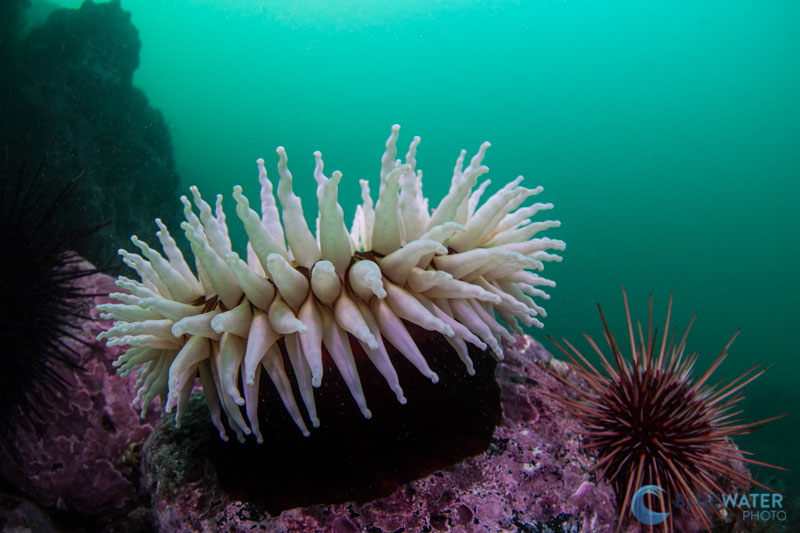
This image shows what good in-body image-stabilization can do. Despite being shot at 1/8th of a second, there is no motion blur in this image and the details are crisp. 1/8, f/13, ISO 320
Perhaps our favorite feature of both the Canon EOS R6 and R5 is the 5 axis in-body image-stabilization (IBIS). The camera is capable of recovering up to 8 stops of exposure when used with an optically stabilized lens. This means that your minimum shutter speed before getting motion blur is 8 stops slower than if the camera did not have IBIS. The implications for this are that you can now shoot at very slow shutter speeds without worrying about motion blur from camera shake. The waters of the Pacific coast are quite dark, and we were able to shoot some of our photos at 1/8th of a second without any motion blur. This allowed us to capture a nice greenish-blue background in lighting situations that we normally could not. A camera that can recover a background from an impossible lighting situation is a camera that can expand a person's creative palette.
Autofocus System
The autofocus system on the EOS R6 is excellent, and the camera's ability to track animal eyes is revolutionary. We took the R6 underwater with EF lenses and EF-EOS R adapter. Even with non-native lenses, the R6's AF system is very quick and accurate. With EF lenses we found that the autofocus acquisition was slightly slower than with Sony's fastest AF systems, like those found on the Sony A7S III and A7R IV. However, with RF lenses, it's likely that autofocus speeds will be about the same. Even with EF lenses, the autofocus on the R6 is better than any mirrorless camera currently in the Nikon line-up, and sufficient for any professional underwater photographer.
The most exciting autofocus feature on the R6 is autofocus tracking. Not only does the R6 track human eyes effectively, but we found in our underwater tests that it was able to acquire fish eyes about 20-60% of the time. Instances of fish eye acquistion were more frequent with macro lenses than wide angle lenses because fish tend to fill the frame more in macro shots. When the camera couldn't follow fish eyes, it was easy to select the AF point anywhere in the seen and have the camera follow that specific point.
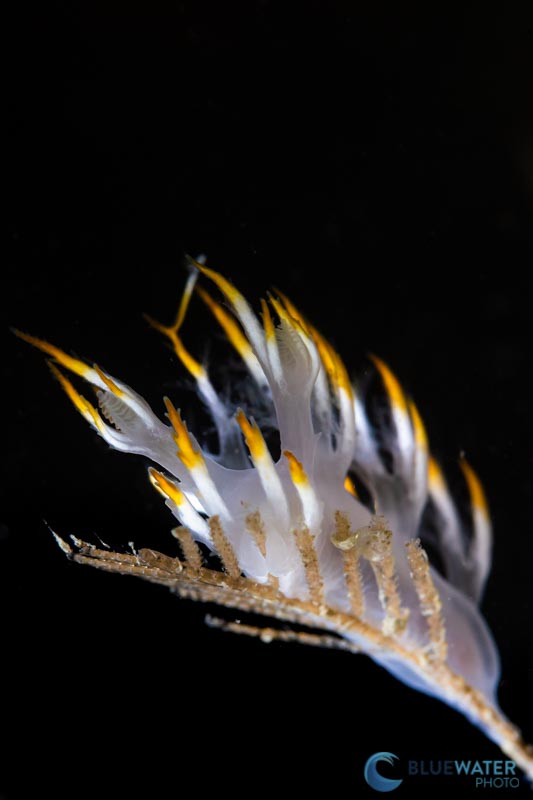
Nudibranchs can be tricky to shoot in high current. Autofocus tracking on the Canon EOS R6 helped us track the nudibranch's rhinophores and keep them in focus.1/160, f/11, ISO 200
Canon EOS R6 for Underwater Photography
For underwater photography, the Canon EOS R6 is the best option for those who are thinking about getting their first professional camera system. If you want the best value, prosumer full-frame camera on the market, the R6 is the right choice. The performance to dollar ratio of the R6 is perhaps one of the highest of any camera. With amazing burst speeds of up to 12 fps mechanical and 20 fps electronic, the EOS R6 will be an excellent camera for wide angle shooters who need to photograph quick-moving pelagic subjects like sharks and dolphins. And with the best IBIS system on the market, the R6 is an excellent tool for underwater photographers that shoot in low lighting situations - especially those that want nice blue backgrounds on dark days. And of course, it's always great to have any tool that can reduce camera shake tumultuous dive conditions with high current. Although animal eye autofocus tracking doesn't always acquire a subject's eyes, it does an excellent job of tracking when it does. And when animal eye AF is not useful, the R6 can hit autofocus points as well as any professional camera. The only real downside that we see with the R6 is that the photo resolution of 20.1 megapixels could be a little higher. But resolution is certainly not everything, and 20 megapixels is enough resolution for most users. If you are a macro oriented shooter, you may want to consider the benefits of the Canon EOS R5.
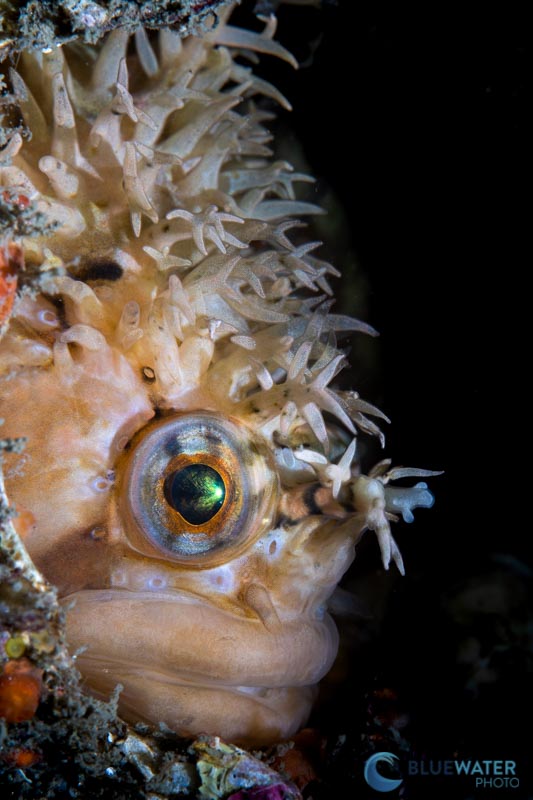
This decorated warbonnet was photographed with the Canon EOS R6 and Canon 100mm macro lens in an Ikelite underwater housing. 1/160, f/16, ISO 200
Canon EOS R6 for Underwater Video
The Canon EOS R6 is just as capable for underwater video as it is for photography. In fact, in many ways, it could be considered more compelling as a video camera. Currently, there are very few options in the prosumer and semi-professional market that can record 4K video @ 60fps. The R6 is the best option in the hybrid mirrorless camera category because of its superior autofocus and IBIS systems. We find that the stabilization on the R6 is the best of any full-frame mirrorless camera, save the R5. It even performed better than the Sony A7S III (a dedicated video camera) when we put the Sony in "action steadyshot" mode. In fact, we were able to capture handheld video with a 100mm macro lens without suffering much in camera shake. The R6 and R5 have been the first hybrid camera systems where we felt comfortable enough to shoot macro video without a tripod. They are also two of the first cameras where continuous autofocus can be a serious option for video shooters. The dual pixel autofocus looks quite cinematic when panning between autofocus points. Changes between autofocus points are slow and steady, and don't warp or jerk around like on other cameras. But it is also important to consider lens selection. Lenses with more focus breathing will result in the necessity of switching to manual focus.
Perhaps most importantly, the ability to shoot 4K up to 60 frames per second allows an underwater videographer to slow down video footage for additional stabilization. This is one of the reasons we were so comfortable shooting macro video without a tripod. There is a slight crop in 16:9 with 4K video, but not noticeable. The camera still uses 94% of the sensor's width (1.07X crop).
For serious videographers, there are limitations to the R6 when compared to the R5. Unlike the EOS R5, the R6 cannot shoot RAW video files or resolutions up to 8K and 4K up to 120 fps. If you want to use RAW files when post processing, the lack of RAW recording is a big drawback for the R6. However, if you are willing to compromise, as most non-cinema shooters do not record RAW, the R6 can still record in C-Log. Combined with internal 10-bit 4:2:2 recording, C-Log allows video shooters to get the most detail and best dynamic range possible from their video. It also allows them to get a better gamut of colors in their footage for color grading during post processing.
There is one final thing to consider when thinking about the R6 as your next video camera - the overheating. With 4K shooting at 60p, you should be able to record for at least 30 minutes during a dive, and closer to 40. While most dives last for longer, it's more than likely that you will not be recording continuously for that amount of time. During all of our dives, we never got close to overheating with the camera. For most, overheating and recording limits will not be a consideration. In fact, you'd be hard pressed to find a camera that does not have recording limits at this end of the market unless you consider video-oriented systems like the Sony A7S III and not hybrid systems.
Who Should Consider Purchasing the Canon EOS R6?
- Experienced photographers who want to upgrade to a full-frame system
- Semi-professionals and professionals who want a great value-for-money underwater camera systems
- Photographers and video shooters who work in low-light situations
- Wide angle photographers
- Pelagic and quick action photographers that need a large buffer
Who Should NOT Consider Purchasing the Canon EOS R6?
- Photographers that need the best camera on the market - consider the Canon EOS R5
- Macro photographers
- Photographers that do a lot of large prints
- Serious video shooters that do a lot of post processing
- Video shooters that need slow motion (120fps) in 4K
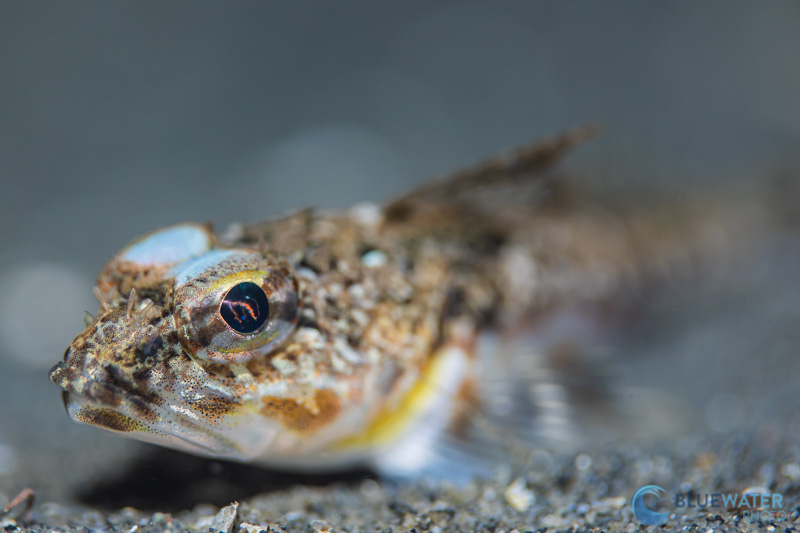
This sculpin was photographed with the Canon EOS R6 and Canon 100mm macro lens in an Ikelite underwater housing. The 100mm macro produces beautiful bokeh. 1/160, f/3.2, ISO 200
Lens Options for Underwater Photography
Because the RF lens mount is so new, there are only a few RF lenses that could be viable for both wide angle and macro photography in the future (e.g., Canon RF 15-35mm f/2.8L for wide and RF 35mm f/1.8 IS Macro for semi-macro and portraits). These RF lenses are superior to EF lenses because the shorter flange distance of the RF mount allows for sharper corners. However, when it comes to lens focal lengths available for underwater photography, there is nothing quite as good as the available EF and EF-S lenses with the EF-EOS R adapter - particularly when it comes to fisheye and macro lenses. We are excited to see many more RF lenses arrive in the near future.
Canon RF 85mm f/2 IS STM Macro Lens: This new lens will be a promising and exciting addition to the RF line up for underwater photography. It will be a good option for full frame shooters that want a lens that's faster than the EF 100mm macro and don't mind the close working distance. The RF 85mm macro will be an excellent lens for blackwater diving an any situation that requires taking full advantage of the EOS R autofocus system. We look forward to taking this lens underwater to test if corner sharpness is truly superior with RF glass.
Recommended Underwater Lenses with the EF-EOS R adapter
Macro
Macro lenses enable to you get close up shots of little critters.
Canon EF 100mm f/2.8L Macro IS: This is the best macro lens for small and shy subjects due to a larger working distance. It’s also an essential tool for super macro photography when combined with a macro diopter. We tested this lens with the Canon EOS R6 and loved how sharp the photos were and the working distance for skittish subjects.
Nauticam Super Macro Converter: The Nauticam super macro converter (SMC-1) is a wet diopter that can help capture sharp macro and super macro images. It’s the strongest, sharpest diopter on the market. If you are a super macro photographer, this diopter is best used with the Canon 100 mm f/2.8 macro.
Wide Angle Fisheye
Wide angle fisheye lenses allow for an ultra-wide field of view but result in a distorted image. The distortion is reduced underwater to the angle of refraction of light through the water.
Canon 8-15mm f/4L circular fisheye: This is the best choice of a full-frame fisheye lens. At 8mm, the lens vignettes over itself creating a cool, artistic, circular fisheye effect. For traditional fisheye images, just zoom into 15mm and you will capture beautiful ultra-wide angle shots without vignetting. We tested this lens with the Canon EOS R6 and loved its functionality and quick autofocus with autofocus tracking.
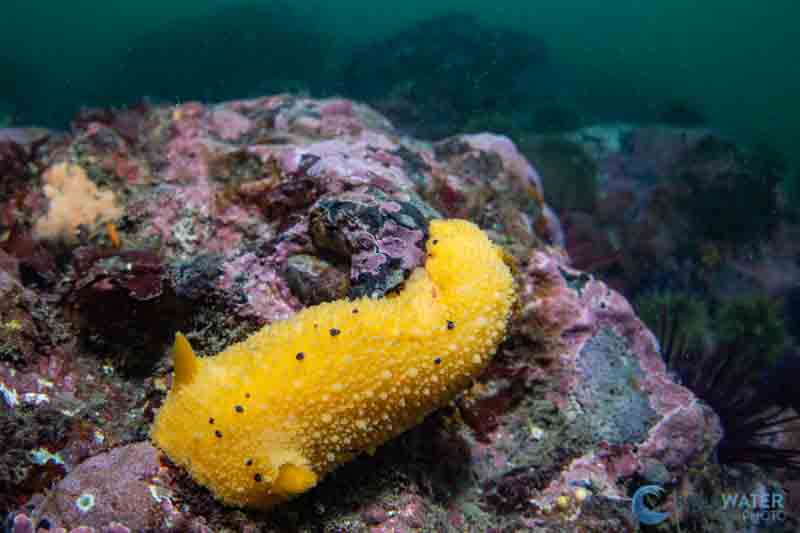
The Canon 8-15mm is a great lens for close focus wide angle photography. This photo was captured with the Canon EOS R6 in an Ikelite EOS R6 underwater housing. 1/50, f/13, ISO 320
Rectilinear Wide Angle
Rectilinear wide angle lenses retain a wide field of view but do not exhibit the distortion found on fisheye lenses. They are great for large animals like sharks and reefscapes. However, they do result in softer corners when behind a traditional dome port which makes them less suitable for reef scenes and photography with a busy background.
Canon 16-35 f/2.8 III Ultra-Wide Zoom lens: This lens is the best choice for those who are buying their first wide-angle lens and don't have a strict budget. Most underwater shooters use rectilinear wide-angle lenses for shooting subjects that don't come close enough to fill the frame with a wide fisheye lens: sharks, whales, sea lions, dolphins, etc.
Canon 16-35mm f/2.8L II Wide-Angle Lens: This has been the most popular rectilinear wide-angle lens for Canon full frame. This lens sat at the top of the selection for the last few years in terms of corner sharpness, speed, and price... although that will change as more new shooters purchase the version III.
Canon 11-24mm f/4L Ultra Wide-Angle Lens: Want the widest lens you can buy? The Canon 11-24mm offers a much wider field of view than the 16mm. This perspective is great for reefscapes, massive wrecks and very wide shots where you do not want the distortion of a fisheye lens. The downside is that this lens is larger, heavier and more expensive than the other wide-angle lens choices.
Underwater Housings for the Canon EOS R6
Due to the popularity of the Canon EOS R6, we anticipate housings from all leading underwater housing manufactures. There are already some excellent housing options available from Nauticam (aluminum) and Ikelite (polycarbonate). We expect Isotta, Aquatica and Sea & Sea to announce their housing options shortly. Ikelite's housing is a light-weight polycarbonate option with excellent TTL compatibility whereas all other major housing brands are anodized aluminum. Isotta housings are very compact and complete with a red finish, Nauticam housings are compatible with Nauticam's renowned optics, Aquatica's housings are some of the most rugged available, and Sea & Sea's housings are elegantly engineered with cool features like glow-in-the-dark buttons.
If you are upgrading to the Canon EOS R6 from the EOS R, you will need a new housing. The Canon EOS R5 will also require separate housing models - be sure to check out our Canon EOS R5 housing options as well.
Ikelite Canon EOS R6 Underwater Housing
The Ikelite Canon EOS R6 underwater housing is a high quality, polycarbonate model with great underwater buoyancy and ergonomics. This housing can be used with the Ikelite Canon TTL converter and Ikelite strobes for extremely fast and accurate exposures underwater. We dived with the Ikelite R6 housing extensively in rough surf conditions and were pleased to see that it didn't take a scratch despite be dragged across a rocky shoreline.
ORDER NOW
Aquatica Canon EOS R6 Underwater Housing
The Aquatica Canon EOS R6 housing might be the most rugged housing for the R6 on the market. It is robust and made of anodized aluminum with a depth rating of 130m (425 ft). The buttons and dials are very robust and are designed with accessibility in mind.
Nauticam Canon EOS R6 Underwater Housing
The Nauticam Canon EOS R6 housing is a top aluminum housing with excellent ergonomics, HDMI Output Support for external recorders, a patented port lock system, and compatibility with professional Nauticam optics.
ORDER NOW
Marelux Canon EOS R6 Underwater Housing
This Marelux Canon EOS R6 underwater housing is built from high-grade aluminum alloy which provides durability and can withstand even the toughest beatings. Ergonomics are also top-notch, all camera controls are readily available at your fingertips and all buttons are clearly labeled. Thanks to its small size, it is great to travel with.
Isotta Canon EOS R6 Underwater Housing
The Isotta Canon EOS R6 anodized aluminum housing is complete with an artisanal red finish. We love the double oring seal, single hand locking system, and stylish but comfortable handles.
Sea & Sea Canon EOS R6 Underwater Housing
The Sea & Sea Canon EOS R6 underwater housing is a high-end, Japanese-made aluminum housing built to withstand any underwater conditions. It comes with useful features like glow-in-the-dark buttons and compatibility with Sea & Sea's TTL converters.
This review was carried out in some of the harshest winter diving we've faced in the Pacific Northwest. After a week of record rain and storms, the water was dreary and dark with heavy surf conditions to greet us. It was absolutely the worst possible time to be taking photos underwater. Yet, we braved backscatter and dark water and pushed this camera to its limits. Boy did it deliver.... The IBIS system enabled us to shoot down to shutter speeds of 1/8th of a second so that we came away with nice green backgrounds without motion blur. The autofocus system tracked fish as they flitted from one rock to the next in heavy currents - even without a good focus light. With 4K video filmed at 60 frames per second, we were able to shoot stable, beautiful macro video even though we forgot our tripod. And to top it off, our Ikelite Canon R6 housing survived a rare crawl of shame as we had to drag it across a rocky shore in rough surf conditions. The odds were against us, so you could image our surprise when we sat in front of our monitor and saw gorgeous colors, dynamic range, and sharp imagery. Editing our 4K video was a joy with C-Log capturing the details easily lost in murky water. And though we wish we had just a little more resolution for cropping our nudibranch photos, we came away from the experience deciding that the Canon EOS R6 is the best full-frame "prosumer" underwater camera in 2021.
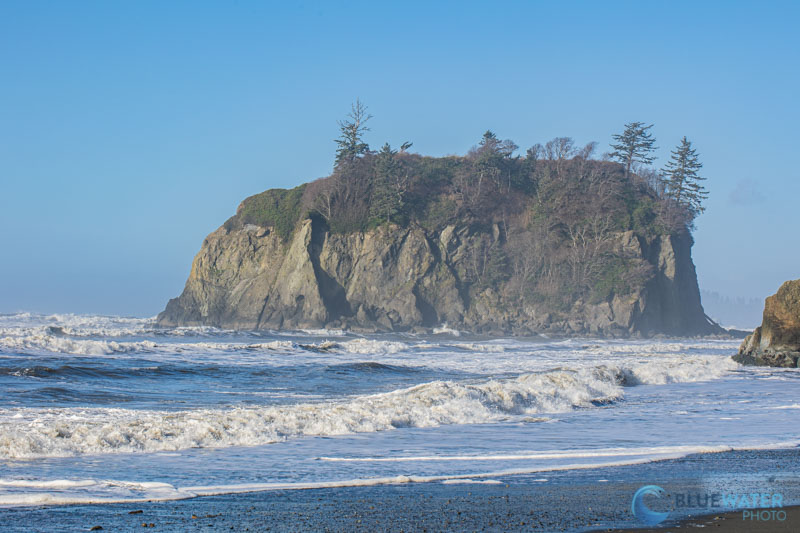
Topside photo with the Canon EOS R6
Purchase a Canon EOS R6 underwater housing at Bluewater Photo:
Nauticam Canon EOS R6 Underwater Housing
Ikelite Canon EOS R6 Underwater Housing
Sea & Sea Canon EOS R6 Underwater Housing
Aquatica Canon EOS R6 Underwater Housing
Isotta Canon EOS R6 Underwater Housing
Marelux Canon EOS R6 Underwater Housing
Need help choosing a housing? Check out our Canon EOS R6 Underwater Housing Buyer's Guide
Learn more here:
https://www.bluewaterphotostore.com/
Contact our sales department:
Phone: 310-633-5052


